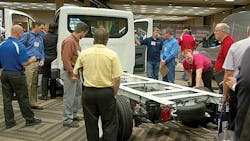THE all-new Transit enters North America for the first time in the spring of 2014, with production starting in Kansas City.
In total, Ford expects to sell more than 400,000 Transits each year by 2016—the equivalent of selling one vehicle every 80 seconds.
Tim Stoehr, Transit product marketing manager, said the Transit will bring a new level of capability and versatility to the medium commercial van market in North America, with a comprehensive range of body styles and derivatives.
The 2014 Ford Transit will replace the current E-Series, which has been America’s best-selling commercial van for 33 years. There are a number of differences.
The Transit It will be offered in 129.9-inch and 147.6-inch wheelbases, three body lengths, and three roof heights: 110.2 inches with an interior cargo height of 81.5 inches; 100.8 inches with an interior cargo height of 72 inches; and 83.2 inches with an interior cargo height of 55.8 inches.
The E-Series (E-150, E-250 Super Duty, and E-350 Super Duty) has one wheelbase and one roof height, along with regular and extended length configurations.
The rear-wheel-drive Transit will offer three engine choices: a flex-fuel (gasoline or E85 compatible) 3.7L Ti-VCT V6; a gasoline 3.5L EcoBoost V6, the same engine available in the Ford F-150 pickup truck; and the diesel-fueled 3.2L Power Stroke five-cylinder. The 3.7-L V6 engine will be available with a compressed natural gas/liquid propane gas prep kit from an upfitter.
The E-Series engine options are a 4.6-L V8, a 5.4-L V8, and a 6.8-L V10.
Minyang Jiang, Transit and Transit Connect brand manager, said the Transit Connect will be offered in two wheelbases (105 and 121 inches) with standard seating for five, and available seating for seven.
Available EcoBoost technology helps optimize power and efficiency. Other features include a low floor for easy loading, entry and exit, and available flip-and-fold seating for customized space. Sliding rear seats help accommodate long legs and large cargo while overhead storage bins help keep personal items secure. An available panoramic roof allows plenty of natural light.
Ford has sold over seven million Transits, which were launched in 1965 in Europe and are now being extended to 118 markets across six continents. The release of the seven millionth Transit was celebrated June 20 at the official opening of a new Transit assembly plant in Nanchang, China.
The Jiangling Xiaolan facility is the result of a $300 million investment by Ford’s strategic partner Jiangling Motors Corp (JMC) and produces JMC-branded vehicles and Ford-branded vehicles for the growing Chinese market.
The 2015 F-Series Super Duty lineup was introduced at State Fair of Texas in September, featuring a second-generation 6.7-liter Power Stroke V8 turbo diesel engine, increased towing capabilities, and a refreshed, Texas-inspired King Ranch model.
Ford is the only heavy-duty pickup truck manufacturer that designs and builds its own diesel engine and transmission combination, ensuring the powertrain will work seamlessly with all chassis components and vehicle calibrations.
A key Ford innovation on the original 6.7-liter Power Stroke V8 turbo diesel was its so-called reverse-flow layout. The advanced design places the exhaust inside the engine’s V-shape while the air intake is positioned on the outside of the V. This segment-exclusive design naturally improves a variety of attributes:
• Shorter airflow from the exhaust system to the turbocharger sitting between the engine’s cylinder banks improves turbo responsiveness—key to providing torque quickly to truck customers when they need it most
• Positioning the turbo inside the engine’s valley helps isolate the engine’s hottest temperatures, improving performance and efficiency, while also reducing noise, vibration, and harshness.
One improvement is a larger GT37 turbocharger that replaces the previous GT32 model, enabling more airflow to the engine to produce more power beyond today’s 400 horsepower and 800 lb-ft of torque.
The GT37 features a single, larger 88-millimeter compressor wheel that replaces the GT32’s dual-sided compressor design. The compressor forces air into the engine’s cylinders to improve performance—especially at high altitude where the air is thinner than at sea level. The turbine size is increased to 72.5 millimeters from 64 millimeters, so exhaust gases have a larger surface area to spin the turbo, providing extra power. The wastegate and the wastegate controls are eliminated, because the turbo operates at lower peak pressures than the GT32. ♦
About the Author
Rick Weber
Associate Editor
Rick Weber has been an associate editor for Trailer/Body Builders since February 2000. A national award-winning sportswriter, he covered the Miami Dolphins for the Fort Myers News-Press following service with publications in California and Australia. He is a graduate of Penn State University.
